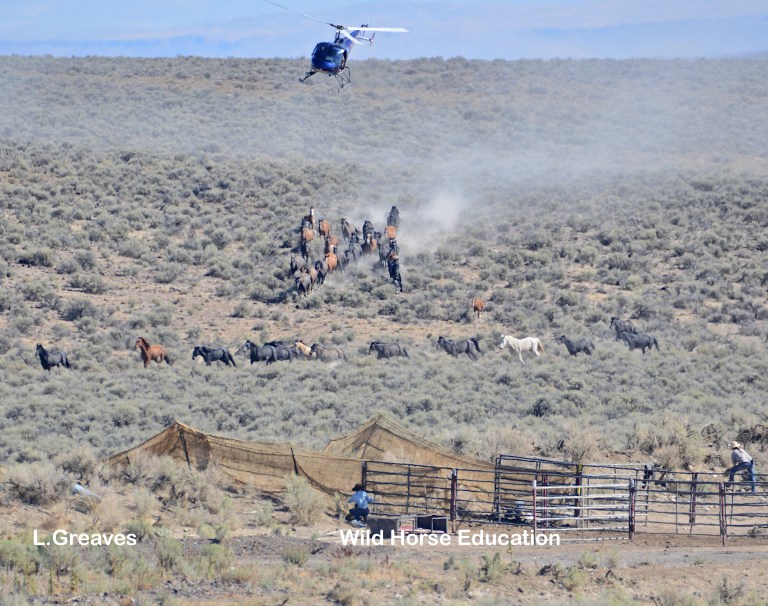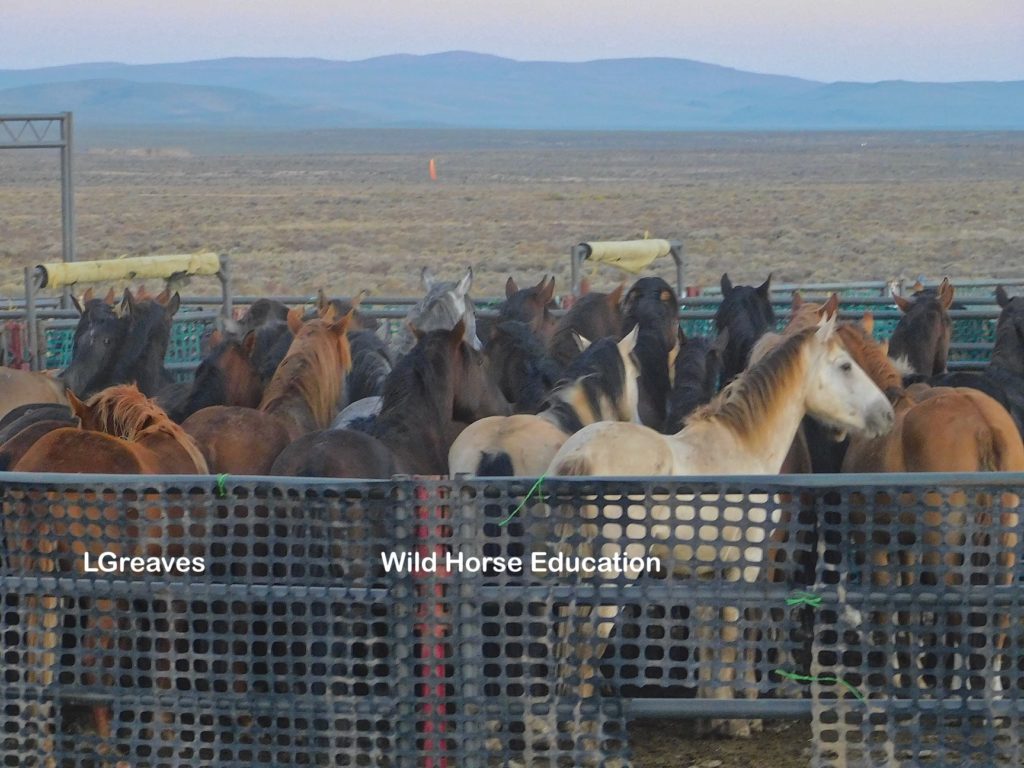by Scott Smith, Communications Director
Of all the deceptions, hypocrisies and outright lies the BLM uses to advance its eradication plan to clear America’s last remaining herds of wild horses from their ancestral homes on public rangeland, the most nefarious and outrageous is this: We’re doing it for their own good.
The BLM gave just a week’s notice before launching a helicopter roundup on Sept. 8 of 1,900 wild horses in the Barren Valley Complex herd management areas in eastern Oregon, where 2,500 wild horses now roam over nearly 1 million acres in three parcels. “They are dying for lack of water and food,” said a BLM wild horse specialist, claiming in an Aug. 31 press release that “a large percentage of the horses are emaciated and dehydrated.”

A review of photos of the Barren Valley roundup taken by observers from Wild Horse Education to document the helicopter harassment does not show the wild horses to be near death, only the majestic animals running for their lives. As of Sept. 23, the BLM had ripped 928 wild horses from their families and home on the range.
Friends of Animals contacted the BLM’s Vale Field Office to request photos of the wild horses’ dire conditions. Despite an email response that a BLM public liaison officer would “try to get some photos,” FoA has received no images to date. Hey, BLM, here’s a PR tip for your vast, multi-million-dollar effort to placate livestock ranchers and give the wild-horse roundup industry more rich paydays at public expense: Don’t pull the emotional trigger of claiming to save “emaciated” wild horses from dying if you can’t even pony up one cell-phone pic.
The BLM noted that local ranchers have been assisting it with providing water to the horses while the removal was being planned. It could be argued that this action would keep the horses from “dying of thirst” as the BLM claimed, obviating the need for any roundup to take place. Or it could be that providing the wild horses with a new source of water makes it that much easier for the helicopter to find them and hunt them down, conveniently making more room for the 3,000-plus pairs of cows and calves permitted to graze on the same parched lands.
In any event, the BLM considers the Barren Valley wild horses hydrated enough to stampede them for miles across the range and cram them into corrals. Once captured, they are accessed by the BLM’s own experts, using the Henneke Body Condition Scoring System. Developed for domestic horses in the 1980s by Dr. Don Henneke at Texas A&M University, the Henneke BCS is a numerical scale used to evaluate the amount of fat on a horse’s body. Scores range from 1 to 9, with one being emaciated and nine being extremely fat. A score of 2-4 falls in the “thin” category, with 5 deemed the ideal condition for most domestic horses, according to Habitat for Horses (HFH) , which assists law enforcement agencies in neglect and abuse cases.
And guess what? The average BCS score for the Barren Valley horses, as documented in the BLM’s daily roundup reports, is 3.25, with a range of 2.5 to 4; the Sept. 23 report for the 51 horses captured (22 stallions, 18 mares, 11 foals) cited an average condition of 3-4. That’s hardly proof that a “large percentage of the horses are emaciated,” as the BLM alleged earlier.
Properly applied, the Henneke BCS is accepted in a court of law, “whereas the terms, ‘skinny,’ ‘thin,’ ‘emaciated’ or ‘fat’ are all subjective terms that have different meanings to different people,” says HFH. “When using the Henneke system, you should always make physical contact, and the kind of touch you use is important. Simply stroking the animal lightly won’t provide an accurate idea of the horse’s condition,” is HFH’s guidance, which raises the issue of how accurate the BLM’s visual-only assessments of these wild horses are, even if you accept the fact that they’re coming from an agency employee paid to justify the roundup.
Trained volunteer observers from Wild Horse Education, an advocacy group based in Reno, Nev., provide an alternate account of the ongoing roundup at the Barren Valley Complex, which is about the size of Rhode Island, with Cape Cod thrown in. According to WHE founder and president Laura Leigh, she and her on-the-ground team report that the “vast majority of the horses captured are “4s and 5s, with some 3s,” using the Henneke lingo. “As with any roundup of these multi-generational family groups, you’ll see a few horses in the 2.5 range; they are typically older animals, often with teeth problems.” Leigh adds that while “a handful of wild horses have come in thin for this time of year, are they in ‘drop-dead’ condition that would justify a label of ‘emergency’? That’s not what we’re seeing.”
Unlike domestic cows and sheep, wild horses are superbly adapted to thrive on the arid landscape on which they evolved. These free-roaming animals, enshrined by Congress as “living symbols of the historic and pioneer spirit of the American West,” are not a bunch of stabled ponies raised on alfalfa, feed supplements and spoiled with carrots and apples. You’d expect wild horses to be lean, with little body fat, especially during dry years when they have to share limited forage with rapacious cows.

“Across wild horse HMAs, the majority of forage is not allocated to wild horses. Instead, BLM allocates significantly more forage to ranchers for grazing their private cattle and sheep at bargain rates,” says Jennifer Best, assistant legal director for Friends of Animals’ Wildlife Law Program, which is litigating for the rights and freedom of wild horses with a number of lawsuits and legal actions.
The watchdog group PEER (Public Employees for Environmental Responsibility) has repeatedly called out the BLM for its failure to address the negative impact of grazing millions of cows and sheep on public rangeland. “While the agency scapegoats wild horses for habitat degradation, its data reveal that most of the allotments within wild horse Herd Management Areas (HMAs) that fail its standards for rangeland health — approximately 11.5 million acres of the 21.5 million acres of allotments within HMAs assessed by BLM to date — identify livestock as a significant cause of that failure,” PEER reported. “Livestock are by far the most frequently identified cause of allotment failure to meet standards for quality of water, vegetation, and soils, as well as the ability to support wildlife nationwide, including for allotments within HMAs.”
The horses taken from the Barren Valley Complex are being trucked off to corrals in Idaho and Nevada from where they’ll be put up for sale or adoption or shipped to long-term holding facilities. Every step of the removal process comes at great expense to the taxpayer. The roundup itself is expected to cost at least $488,000, and warehousing the wild horses who aren’t sold off or adopted will cost millions more over their lifetimes in captivity. Of course, the ultimate cost to the horses is their freedom, or worse. Twelve Barren Valley wild horses have been killed so far because of the roundup, which is expected to continue until another thousand can be captured.
To paraphrase a tragic justification from another failed war, “We had to destroy the herd in order to save it.”
Friends of Animals has a much better, more humane solution: Remove domestic livestock from the herd management areas so that wild horses (and other wildlife) can live free on the land they’ve called home for centuries.
Editor’s note: This is the latest article in a series of Friends of Animals’ “Tales, Tails and Tells” blog posts that investigates the Bureau of Land Management’s continuing wild horse eradication campaign. Previous articles:
The BLM’s deadly game of pin the blame on wild horses
Sand Wash Basin wild horses are latest victims of BLM’s overpopulation lies
BLM: Don’t blame wildfires on wild horses. Instead, use them as four-legged firefighters
Why the BLM’s use of drought to wipe out wild horses doesn’t hold water
National Geographic (Mis)Adventures writing about the wild horse ‘controversy’

